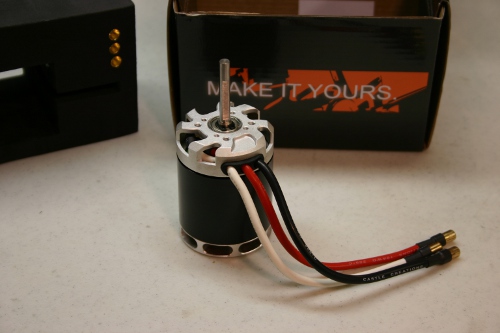KDE 700XF – 495kV
by
Nick Lenn
I’ve been fortunate to have the KDE 700XF-495kv motor for about the last 8 weeks to run through the paces. After watching their promotional videos and seeing the quality, thought, and effort that goes into these motors I just had to give one a shot. My Whiplash is a large heli for it’s class so what better platform could you ask to test such a monster motor.

Right out of the package the quality and beefiness of this motor is apparent. I’m not going to get into too much detail of the internals because KDE themselves have put out some exceptional videos going over the internal construction and features of the motor. There were a couple things that really stood out. First, I love the grommet around the motor wires where it exits the base of the motor. That’s a very classy touch as I’ve had numerous motors chaff their wires there. Second, the large gauge regular fine strand wire is a really neat feature. This allows the user to cut and solder the motor wires to desired length. It also gives them a lot more flexibility which is really nice. Third, the size and weight are immense! It’s a very large and coincidentally very heavy motor. Weighing in at over a 1/2lb more than the Align 700mx this was replacing I did have a bit of concern but increased weight is also a bit expected when upgrading to a much higher power motor.
Install went easy as expected with the included 6mm bullets and after programming my CC ICE 120HV ESC to KDE’s recommended settings I was out for some test flying!
The most obvious difference in the air is the torque of the motor. This thing pulls like a freight train. Bogging… what? There was a night and day power difference between the 700xf and the 700mx despite the heli being significantly heavier. The larger mass of the outer motor can provides an incredible amount of inertia and the crispness of the power delivery is very apparent. I actually dropped from 2100rpm to 2050rpm because the increased crispness and response from the motor allowed me to run a slightly lower headspeed and get the same pop from the collective. The only warning I’ll give is with the massive power of this motor it will take a bit more tuning to get your tail dialed in if you’re going to run lower headspeeds. It’s a powerfull motor and has the grunt behind it to push that tail through anything.
At first I was experiencing some quite high motor and ESC temps but after talking with Patrick at KDE I dropped the motor timing to LOW in the CC software and temps reduced immediately. It tends to run the 120HV about 10*-15* warmer than with the Align motor but after dropping to LOW timing it’s well below anything to worry about.
After putting about 30 flights on the motor I switched back to the 700mx just to be thorough and unfortunately the decreased weight became very apparent. The power was down once again but I did prefer the way the heli “sat” when doing on the deck maneuvers and auto performance was better. At first I was a bit bummed but then with some quick disc loading calculations I decided to give 710mm blades a try. I mean hey, if it’s a big heli, and the motor can definitely spin them, then why not? BINGO! This was the ticket I was after. The disc loading was absolutely identical with the 710mm blades and the 700xf motor as it was with the 690mm blades and the 700mx motor. The huge exception to this was that I had the added bonus of a monster powered motor and I really preferred the way the heli flew with the 710mm blades. Much bigger! Not to mention it autos fantastic.
In recap I think the KDE 700xf-495kv motor is an exceptional motor for the dollar. The power is absolutely undeniable and the quality is second to none. The only, and I do mean ONLY, downfall to this motor is the weight. If you’re working with an already pudgy heli then you might want to increase blade size or run slightly higher headspeed. In my case that was a very small price to pay for the outcome and I don’t see it leaving it’s current mounting spot any time soon.
Fantastic job on this motor KDE! The quality and effort put into it really shows. Not to mention it’s got the power to impress even the most power hungry pilots!


